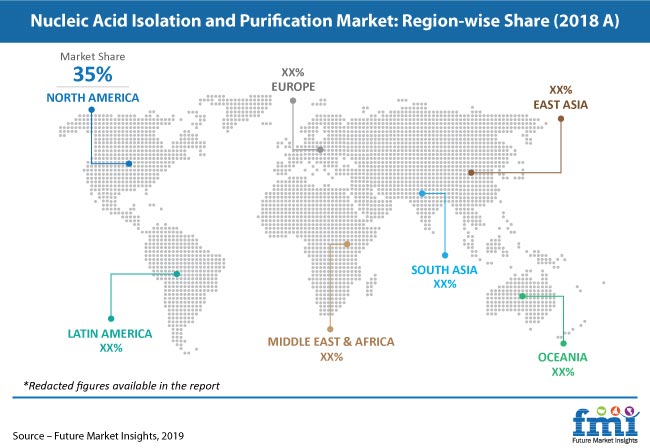Future Market Insights (FMI), in its latest publication, outlines the future trajectory of the global nucleic acid isolation and purification market through 2029. According to the report, worldwide sales of nucleic acid isolation and purification kits were valued at ~US$ 830 million in 2018, and are estimated to register a Y-o-Y growth of ~4% in 2019. As the consistency and reliability of molecular diagnostic results relies heavily on the quality of genetic material i.e. DNA and RNA, manufacturers are focusing on offering high-quality products, ensuring improved yield and purity.
With growing need to understand and characterize microbial diversity, including that associated with human body, governments as well as private companies are increasingly investing in life science projects, thereby creating a greater demand for nucleic acid isolation and purification. While the high cost challenge persists, shortage of skilled professionals in healthcare and biopharma industries remain the longstanding challenges.
Request a Sample of this Report @ https://www.futuremarketinsights.com/reports/sample/rep-gb-10035

“Rapid and efficient methods or products to extract genomic RNA and DNA from virtually any biological sample have been growing in demand to ensure the success of downstream applications in molecular biology. With growing research on detection of tumor specific changes, FMI study finds that nucleic acid isolation and purification market vendors are exploring new technologies to facilitate ease-of-use and minimize user-error of their products.”
Future market Insights’ study reveals that the nucleic acid isolation and purification market is likely to expand at a CAGR of ~5% during the period 2019-2029. One of the key influencing factors is manufacturers’ focus to direct their investments towards advanced technologies such as magnetic-bead or bead-beating technology, to align with end users’ demand for an effective system for extraction of high-quality starting material and efficient inhibitor removal. The unique challenges for extracting and purifying nucleic acid from different organisms and tissue types, have also brought more focus on customized systems and solutions.
Advances in Microbiome Research to Dictate Manufacturers’ Growth Strategies
In comparison with RNA isolation kits, manufacturers continue to increase innovations and production of DNA isolation kits, as the category is expected to account for larger share in the market during the forecast period. As per the study, lucrative opportunities are identified in increasing application scope of DNA isolation and purification kits in various academic research institutes, contract research organizations, and biotechnologies companies to not only successfully extract the DNA but also to minimize the presence of contaminants and prevent nucleic acid degradation during preparation. As genomic and microbiome research advances, manufacturers are working on automating the nucleic acid isolation and purifications kits to recover DNA and RNA from the toughest samples used in microbiome work such as soil and stool samples.
Growth prospects of the nucleic acid isolation and purification market, as the study opines, are relatively high in developed countries of North America and Europe. Hefty investments in R&D on molecular biology and precision medicines over gradual increase in the prevalence of cancer, genetic disorders, and complex diseases are likely to influence the manufacturers to enhance their production capabilities.
Tapping into opportunities in China and Japan for acquiring local players and increasing manufacturing facilities will provide the added advantage to gain a new customer base. As innovations zoom in, a number of market players are working on offering products that are free of toxic organic solvents and enable cost-effective method to extract and purify PCR-ready DNA or RT-PCR-ready RNA from numerous samples.
Ask An Analyst @ https://www.futuremarketinsights.com/ask-the-analyst/rep-gb-10035
The report also offers an incisive outlook on the competitive landscape of nucleic acid isolation and purification market. As per the study, extensive M&A activities and new launches remain the key focus areas of the market players. In addition, they are emphasizing on strengthening outsourcing and solutions through strategic collaborations.
The Broader Perspective
While the use of nucleic acid isolation and purification kits remained confined in academic research, demand from contract research organizations and biotechnology companies is gathering pace in the recent years. With growing need for separation and purification of nucleic moieties in studying diseases associated with various pathogens at genetic level, manufacturers are targeted towards automating sample purification, while reducing hands-on time and maintaining the top performance for downstream analysis.
Product
- DNA Extraction and Purification Kits
- Column Based Kits
- Magnetic Beads
- Reagent Based Kits
- RNA Extraction and Purification Kits
- Column Based Kits
- Magnetic Beads
- Reagent Based Kits
Application
- Plasmid Isolation and Purification
- DNA Isolation and Purification
- RNA Isolation and Purification
End User
- Pharmaceutical Companies
- Biotechnology Companies
- Contract Research Organizations
- Academic Research Institutes
Region
- North America
- Latin America
- Europe
- South Asia
- East Asia
- Oceania
- Middle East and Africa
Buy Complete Report @ https://www.futuremarketinsights.com/checkout/10035
Contact Us:
Future Market Insights
Unit No: AU-01-H Gold Tower (AU), Plot No: JLT-PH1-I3A,
Jumeirah Lakes Towers, Dubai,
United Arab Emirates
For Sales Enquiries: sales@futuremarketinsights.com
For Media Enquiries: press@futuremarketinsights.com
Website: https://www.futuremarketinsights.com